
- Home
- Brand
- Distortions (45)
- Gemmy (398)
- Halloween (18)
- Handmade (30)
- Haunted Hill Farm (19)
- Home Accents Holiday (139)
- Magic Power (14)
- Morbid Enterprises (28)
- Morris (52)
- Morris Costumes (100)
- Seasonal Visions (146)
- Skeleton Store (13)
- Spirit (45)
- Spirit Halloween (184)
- Tekky (16)
- Tekky Toys (24)
- Trick Or Treat (16)
- Unknown (12)
- Www.horror-hall.com (24)
- Xcoser (85)
- ... (4408)
- Material
- Occasion
- Power Type
- Shipping Policy
- Type
- Action Figure (8)
- Animated Prop (5)
- Animatronic (27)
- Cosplay Helmet (6)
- Cosplay Mask Helmet (8)
- Doll (9)
- Halloween (26)
- Halloween Decor (7)
- Halloween Prop (9)
- Helmet (5)
- Mask (5)
- Prop (25)
- Props (8)
- Puppet (6)
- Replica Weapons (4)
- Seasonal Props (7)
- See Description (4)
- Skeleton (6)
- Statue (7)
- Yard Decor (5)
- ... (5629)
13.5 LIGHT-UP FRANKENSTEIN MONSTER HEAD HALLOWEEN PROP decoration horror rare
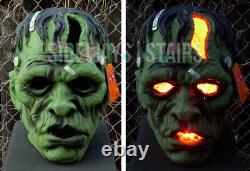
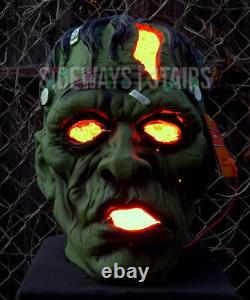
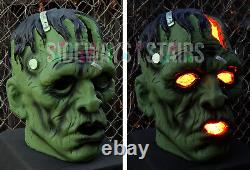
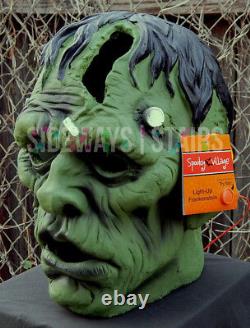
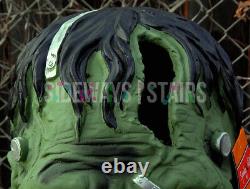

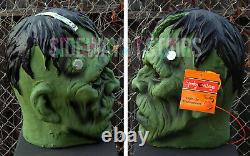
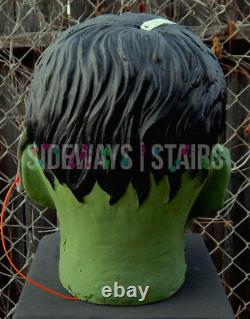
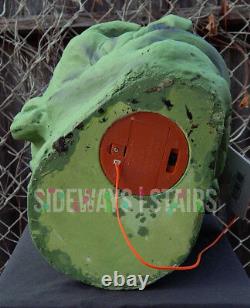



Check out our other new & used items>>>>> HERE! A new, limited-run, light-up decorative piece from the 2017 Halloween season. 13.5 LIGHT-UP FRANKENSTEIN'S MONSTER BUST HALLOWEEN PROP. The tortured details are sure to spook trick-or-treaters this Halloween season!
This "reanimated" monster head is complete with a tormented, ghoulish face, creepy green skin tone, and "metal" bolts/pieces. Ideal for displaying during the Halloween season though lovers of all things macabre can enjoy it all-year-round as it sits upon a shelf or in a corner in their decorated home of horrors. Makes a very cool (and creepy) night light!
When activated, either by the "Try Me". Button or "On/Off" switch, this decorative piece will light inside making the hollow space (eyes, mouth, head hole). Glow a radiant, demon-red (though the light appears orange in the photos). The "Try Me" button activates the red light and stays on for as long as you keep the button pressed. The "On/Off" switch will activate the light, which will stay on until the switch is set back to the "Off" position.
Made of plaster and hand-painted! This awesome Halloween time home decoration is constructed of plaster, has some real weight to it and is hand-painted.
The designer/scu lptor of the original mold and overall look did a wonderful job including detail, we particularly love the way they disfigured the jaw and mouth. Because this monster head is made of plaster its paint can easily be touched-up, enhanced or a whole new paint scheme can be applied. Uses 2 "AA" batteries to operate light.
Approximately 13 1/2"(H) x 9 1/2"(W) x 10 1/2(D). New with tags and some shelf wear.
Though the monster bust has an intentional distressed/weathered look it may have a few small, unintentional missing specks of paint and/or plaster (this can easily be touched up). There is an intentional, small hole at the side of the head where the tags hang from. For photo purposes and to test for working order the light was turned on for a short period of time. We have a few of these light up monster heads - each is new with tags and. ALL PHOTOS AND TEXT ARE INTELLECTUAL PROPERTY OF SIDEWAYS STAIRS CO. " Frankenstein's monster, often erroneously referred to as "Frankenstein, is a fictional character who first appeared in Mary Shelley's 1818 novel Frankenstein; or, The Modern Prometheus.Shelley's title thus compares the monster's creator, Victor Frankenstein, to the mythological character Prometheus, who fashioned humans out of clay and gave them fire. In Shelley's Gothic story, Victor Frankenstein builds the creature in his laboratory through an ambiguous method consisting of chemistry and alchemy. Shelley describes the monster as 8-foot-tall (2.4 m), hideously ugly, but sensitive and emotional. The monster attempts to fit into human society but is shunned, which leads him to seek revenge against Frankenstein. According to the scholar Joseph Carroll, the monster occupies "a border territory between the characteristics that typically define protagonists and antagonists"...
Shelley described Frankenstein's monster as an 8-foot-tall (2.4 m) creature of hideous contrasts. His limbs were in proportion, and I had selected his features as beautiful. His yellow skin scarcely covered the work of muscles and arteries beneath; his hair was of a lustrous black, and flowing; his teeth of a pearly whiteness; but these luxuriances only formed a more horrid contrast with his watery eyes, that seemed almost of the same colour as the dun-white sockets in which they were set, his shrivelled complexion and straight black lips. A picture of the creature appeared in the 1831 edition. Early stage portrayals dressed him in a toga, shaded, along with the monster's skin, a pale blue.
Throughout the 19th century, the monster's image remained variable according to the artist. The best-known image of Frankenstein's monster in popular culture derives from Boris Karloff's portrayal in the 1931 movie Frankenstein, in which he wore makeup applied, and according to a format designed by, Jack P. Pierce and possibly suggested by director James Whale.Karloff played the monster in two more Universal films, Bride of Frankenstein and Son of Frankenstein; Lon Chaney, Jr. Took over the part from Karloff in The Ghost of Frankenstein; Bela Lugosi portrayed the role in Frankenstein Meets the Wolf Man; and Glenn Strange played the monster in the last three Universal Studios films to feature the character - House of Frankenstein, House of Dracula, and Abbott and Costello Meet Frankenstein.
But their makeup replicated the iconic look first worn by Karloff. To this day, the image of Karloff's face is owned by his daughter's company, Karloff Enterprises, for which Universal replaced Karloff's features with Glenn Strange's in most of their marketing. Since Karloff's portrayal, the creature almost always appears as a towering, undead-like figure, often with a flat-topped angular head and bolts on his neck to serve as electrical connectors or grotesque electrodes. He wears a dark, usually tattered, suit having shortened coat sleeves and thick, heavy boots, causing him to walk with an awkward, stiff-legged gait (as opposed to the novel, in which he is described as much more flexible than a human). The tone of his skin varies (although shades of green or gray are common), and his body appears stitched together at certain parts (such as around the neck and joints).
This image has influenced the creation of other fictional characters, such as the Hulk. In the 1973 TV mini-series Frankenstein: The True Story, a different approach was taken in depicting the monster: Michael Sarrazin appears as a strikingly handsome man who later degenerates into a grotesque monster due to a flaw in the creation process. In the 1994 film Mary Shelley's Frankenstein, the creature is played by Robert De Niro in a nearer approach to the original source, except this version gives the creature balding grey hair and a body covered in bloody stitches. He is, as in the novel, motivated by pain and loneliness. In this version, Frankenstein gives the monster the brain of his mentor, Doctor Waldman, while his body is made from a man who killed Waldman while resisting a vaccination.
The monster retains Waldman's "trace memories" that apparently help him quickly learn to speak and read. In the 2004 film Van Helsing, the monster is shown in a modernized version of the Karloff design. He is 8 to 9 feet (240270 cm) tall, has a square bald head, gruesome scars, and pale green skin. The electricity is emphasized with one electrified dome in the back of his head and another over his heart. It also has hydraulic pistons in its legs, essentially rendering the design as a steam-punk cyborg.
Although not as eloquent as in the novel, this version of the creature is intelligent and relatively nonviolent. In 2004, a TV mini-series adaptation of Frankenstein was made by Hallmark. Luke Goss plays The Creature. This adaptation more closely resembles the monster as described in the novel: intelligent and articulate, with flowing, dark hair and watery eyes. The 2014 TV series Penny Dreadful also rejects the Karloff design in favor of Shelley's description. This version of the creature has the flowing dark hair described by Shelley, although he departs from her description by having pale grey skin and obvious scars along the right side of his face. In this series, the monster names himself "Caliban", after the character in William Shakespeare's The Tempest. In the series, Victor Frankenstein makes a second and third creature, each more indistinguishable from normal human beings.... Frankenstein's Monster has appeared in some Looney Tunes cartoons. A robotic version of Frankenstein's Monster appears in the cartoon short Dr. He ends up beating up the Tasmanian Devil and then beats up his creator Bugs Bunny. Frankenstein's Monster appears in The Night of the Living Duck. He is seen in Daffy Duck's dream amongst the monsters in the nightclub that Daffy is in and accompanied by his bride. A Stone Age version of Frankenstein's monster appears in various Flintstones media, named Frankenstone or Frankenstone monster. He first appears in The Flintstones Meet Rockula and Frankenstone. In The Flintstone Comedy Show, he is shown to have a family. Marvel Comics has its adaptation of Frankenstein's Monster and its various clones. DC Comics has its adaptation of Frankenstein and also featured Young Frankenstein. The eponymous creature in Stephen King's It takes the form of the Boris Karloff incarnation of Frankenstein's monster at one point. Lego has its adaptations of Frankenstein's Monster. Frankenstein's Monster appears in Series 4 of Lego Minifigures as "The Monster" where he was created by the Crazy Scientist (who was also in the same Minifigure series). The Monster was also playable in Lego City Undercover. Series 14 features the "Horror Rocker" who is a rock music version of Frankenstein's Monster.In Lego Monster Fighters, another adaptation of Frankenstein's Monster appeared as the "Crazy Scientist's Monster" where he was built by a Crazy Scientist that was associated with the same Lego theme. There is also a related monster in this theme called the "Monster Butler" who works for Lord Vampyre at his haunted house. Frankenstein's Monster appears in Fables. Outside of his creation at the hands of Victor Frankenstein, he was later reanimated by the Nazis during World War II where he fought Bigby Wolfe. His still-animated head is kept in the business offices in the Woodlands where he is good friends with the winged monkey Bufkin, tends to chat with Bigby Wolfe from time to time, and tends to have "phantom thirsts" in which the last time he was given water, it rusted the bottom of his cage.
Frankenstein's Monster is also a good friend of the Magic Mirror. Frankenstein's Monster appears in the light novel Fate/Apocrypha, as a servant of the Berserker class and is depicted as a young girl. She also appears in another installment of the series Fate/Grand Order. Frankenstein's monster appears in the twelfth episode "And the Broken Staff" of The Librarians, portrayed by Michael Gladis. He and the Queen of Hearts are brought to life by Prospero to distract the Librarians.
The Creature is a recurring boss in Konami's Castlevania series of video games. Halloween or Hallowe'en (a contraction of All Hallows' Evening), also known as Allhalloween, All Hallows' Eve, or All Saints' Eve, is a celebration observed in a number of countries on 31 October, the eve of the Western Christian feast of All Hallows' Day. It begins the three-day observance of Allhallowtide, the time in the liturgical year dedicated to remembering the dead, including saints (hallows), martyrs, and all the faithful departed. It is widely believed that many Halloween traditions originated from ancient Celtic harvest festivals, particularly the Gaelic festival Samhain; that such festivals may have had pagan roots; and that Samhain was Christianized as Halloween by the early Church.
Some believe, however, that Halloween began solely as a Christian holiday, separate from ancient festivals like Samhain. Halloween activities include trick-or-treating (or the related guising), attending Halloween costume parties, carving pumpkins into jack-o'-lanterns, lighting bonfires, apple bobbing, divination games, playing pranks, visiting haunted attractions, telling scary stories, and watching horror films.In many parts of the world, the Christian religious observances of All Hallows' Eve, including attending church services and lighting candles on the graves of the dead, remain popular, [21][22][23] although elsewhere it is a more commercial and secular celebration. [24][25][26] Some Christians historically abstained from meat on All Hallows' Eve, a tradition reflected in the eating of certain vegetarian foods on this vigil day, including apples, potato pancakes, and soul cakes. Death, due to its prominent place in human culture, is frequently imagined as a personified force, also known as the Grim Reaper. In some mythologies, the Grim Reaper causes the victim's death by coming to collect them.
In turn, people in some stories try to hold on to life by avoiding Death's visit, or by fending Death off with bribery or tricks. Other beliefs hold that the Spectre of Death is only a psychopomp, serving to sever the last ties between the soul and the body, and to guide the deceased to the afterlife, without having any control over when or how the victim dies. Death is most often personified in male form, although in certain cultures Death is perceived as female (for instance, Marzanna in Slavic mythology, or La Catrina in Mexico).... According to the Midrash, the Angel of Death was created by God on the first day.
[16] His dwelling is in heaven, whence he reaches earth in eight flights, whereas Pestilence reaches it in one. [17] He has twelve wings. [18] "Over all people have I surrendered thee the power, " said God to the Angel of Death, only not over this one i.Moses which has received freedom from death through the Law. [19] It is said of the Angel of Death that he is full of eyes. In the hour of death, he stands at the head of the departing one with a drawn sword, to which clings a drop of gall. As soon as the dying man sees Death, he is seized with a convulsion and opens his mouth, whereupon Death throws the drop into it.
This drop causes his death; he turns putrid, and his face becomes yellow. [20] The expression "the taste of death" originated in the idea that death was caused by a drop of gall. The soul escapes through the mouth, or, as is stated in another place, through the throat; therefore, the Angel of Death stands at the head of the patient Adolf Jellinek, l.When the soul forsakes the body, its voice goes from one end of the world to the other, but is not heard Gen. The drawn sword of the Angel of Death, mentioned by the Chronicler I. Job 15:22; Enoch 62:11, indicates that the Angel of Death was figured as a warrior who kills off the children of men. "Man, on the day of his death, falls down before the Angel of Death like a beast before the slaughterer" Grünhut, "Liuim", v.
200 said: "The Angel of Death said to me,'Only for the sake of the honor of mankind do I not tear off their necks as is done to slaughtered beasts'"'Ab. In later representations, the knife sometimes replaces the sword, and reference is also made to the cord of the Angel of Death, which indicates death by throttling. Moses says to God: "I fear the cord of the Angel of Death" Grünhut, l. Of the four Jewish methods of execution, three are named in connection with the Angel of Death: Burning (by pouring hot lead down the victim's throat), slaughtering (by beheading), and throttling. The Angel of Death administers the particular punishment that God has ordained for the commission of sin. A peculiar mantle "idra"-according to Levy, Neuhebr. 32, a sword belongs to the equipment of the Angel of Death Eccl.The Angel of Death takes on the particular form which will best serve his purpose; e. He appears to a scholar in the form of a beggar imploring pity The beggar should receive Tzedakah. When pestilence rages in the town, walk not in the middle of the street, because the Angel of Death i. Pestilence strides there; if peace reigns in the town, walk not on the edges of the road.
When pestilence rages in the town, go not alone to the synagogue, because there the Angel of Death stores his tools. If the dogs howl, the Angel of Death has entered the city; if they make sport, the prophet Elijah has come B. The "destroyer" (saan ha-mashit) in the daily prayer is the Angel of Death Ber.
Ma'ase Torah compare Jellinek, B. 98 says: There are six Angels of Death: Gabriel over kings; apiel over youths; Mashbir over animals; Mashit over children; Af and emah over man and beast. Scholars and the Angel of Death. Talmud teachers of the 4th century associate quite familiarly with him. When he appeared to one on the street, the teacher reproached him with rushing upon him as upon a beast, whereupon the angel called upon him at his house.To another, he granted a respite of thirty days, that he might put his knowledge in order before entering the next world. To a third, he had no access, because he could not interrupt the study of the Talmud. To a fourth, he showed a rod of fire, whereby he is recognized as the Angel of Death M. He often entered the house of Bibi and conversed with him ag. Often, he resorts to strategy in order to interrupt and seize his victim B.
The death of Joshua ben Levi in particular is surrounded with a web of fable. When the time came for him to die and the Angel of Death appeared to him, he demanded to be shown his place in paradise. When the angel had consented to this, he demanded the angel's knife, that the angel might not frighten him by the way.
This request also was granted him, and Joshua sprang with the knife over the wall of paradise; the angel, who is not allowed to enter paradise, caught hold of the end of his garment. Joshua swore that he would not come out, and God declared that he should not leave paradise unless he was absolved from his oath; if not absolved, he was to remain. The Angel of Death then demanded back his knife, but Joshua refused.At this point, a heavenly voice (bat ol) rang out: Give him back the knife, because the children of men have need of it will bring death. To never forget the name he carved Troke into his arm the Angel of Death's chosen name. Trick-or-treating is a Halloween ritual custom for children and adults in many countries.
Children in costumes travel from house-to-house, asking for treats with the phrase "Trick or treat". The "trick" refers to a threat, usually idle, to perform mischief on the homeowners or their property if no treat is given. Trick-or-treating usually occurs on the evening of October 31. Some homeowners signal that they are willing to hand out treats by putting up Halloween decorations outside their doors; others simply leave treats available on their porches for the children to take freely. In North America, trick-or-treating has been a Halloween tradition since the late 1920s.
In Britain and Ireland the tradition of going house-to-house collecting food at Halloween goes back at least as far as the 16th century, as had the tradition of people wearing costumes at Halloween. [3] While going house-to-house in costume has remained popular among Scots and Irish, the custom of saying "trick or treat" has only recently become common. In the latter, this practice is called calaverita (Spanish for "sugar skull"), and instead of "trick or treat", the children ask ¿me da mi calaverita? Can you give me my sugar skull?
Where a calaverita is a small skull made of sugar or chocolate.... Almost all pre-1940 uses of the term "trick-or-treat" are from the United States and Canada. Trick-or-treating spread throughout the United States, stalled only by sugar rationing that began in April 1942 during World War II and did not end until June 1947. Early national attention to trick-or-treating was given in October 1947 issues of the children's magazines Jack and Jill and Children's Activities, [38] and by Halloween episodes of the network radio programs The Baby Snooks Show in 1946 and The Jack Benny Show and The Adventures of Ozzie and Harriet in 1948.
[39] Trick-or-treating was depicted in the Peanuts comic strip in 1951. [40] The custom had become firmly established in popular culture by 1952, when Walt Disney portrayed it in the cartoon Trick or Treat, and Ozzie and Harriet were besieged by trick-or-treaters on an episode of their television show. [41] In 1953 UNICEF first conducted a national campaign for children to raise funds for the charity while trick-or-treating. Although some popular histories of Halloween have characterized trick-or-treating as an adult invention to re-channel Halloween activities away from Mischief Night vandalism, there are very few records supporting this. Des Moines, Iowa is the only area known to have a record of trick-or-treating being used to deter crime. [43] Elsewhere, adults, as reported in newspapers from the mid-1930s to the mid-1950s, typically saw it as a form of extortion, with reactions ranging from bemused indulgence to anger. [44] Likewise, as portrayed on radio shows, children would have to explain what trick-or-treating was to puzzled adults, and not the other way around. Sometimes even the children protested: for Halloween 1948, members of the Madison Square Boys Club in New York City carried a parade banner that read American Boys Don't Beg. [45] The National Confectioners Association reported in 2005 that 80 percent of adults in the United States planned to give out confectionery to trick-or-treaters, [46] and that 93 percent of children, teenagers, and young adults planned to go trick-or-treating or participating in other Halloween activities. A stuffed toy is a toy with an outer fabric sewn from a textile and then stuffed with a flexible material. In North American English, they are variously referred to as plush toys, stuffed animals, plushies, snuggies, stuffies, or snuggled animals. [citation needed] In British English, they are soft toys or cuddly toys. The toys developed in their current form in the early years of the 20th century and have remained consistently popular with children throughout. Different fads have caused specific toys to surge in popularity among adults and collectors. Noticeable examples include Tickle Me Elmo and Beanie Babies. Textiles commonly used include plain cloth and pile textiles like plush or terrycloth.Common stuffing materials are synthetic fiber batting, cotton, straw, wood wool, plastic pellets or beans. Stuffed toys are made in many different forms, often resembling real animals (sometimes with exaggerated proportions), legendary creatures, cartoon characters or inanimate objects. They can be used as comfort objects, for display or for collecting; or given as gifts, such as for graduation, Valentine's Day, Christmas, or birthdays. L, or really any celebration.
They are commonly gifted to children, but can be given to anybody.... The first commercial concern to create stuffed toys was the German Steiff company in 1880. Steiff used new technology developed for upholstery to make their stuffed toys.
[1] In 1892, the Ithaca Kitty became one of the first mass-produced stuffed animal toys in the United States. [2] In 1903 Richard Steiff designed a soft bear that differed from earlier traditional rag dolls, because it was made of plush furlike fabric. [1] At the same time in the USA, Morris Michtom created the first teddy bear, after being inspired by a drawing of Theodore "Teddy" Roosevelt with a bear cub.[3] The character Peter Rabbit from English author Beatrix Potter was the first stuffed toy to be patented, in 1903. Sock monkeys are a type of handmade stuffed monkey made out of socks, which first appeared in the US during the Great Depression.
The item "13.5 LIGHT-UP FRANKENSTEIN MONSTER HEAD HALLOWEEN PROP decoration horror rare" is in sale since Sunday, April 7, 2019. This item is in the category "Collectibles\Holiday & Seasonal\Halloween\Current (1991-Now)\Props". The seller is "sidewaysstairsco" and is located in Santa Ana, California. This item can be shipped to United States, Canada, United Kingdom, China, Mexico, Germany, Japan, Brazil, France, Australia, Russian federation, Denmark, Romania, Slovakia, Bulgaria, Czech republic, Finland, Hungary, Latvia, Lithuania, Malta, Estonia, Greece, Portugal, Cyprus, Slovenia, Sweden, South Korea, Indonesia, Taiwan, South africa, Thailand, Belgium, Hong Kong, Ireland, Netherlands, Poland, Spain, Italy, Austria, Bahamas, Israel, New Zealand, Philippines, Singapore, Switzerland, Norway, Saudi arabia, Ukraine, United arab emirates, Qatar, Kuwait, Bahrain, Croatia, Malaysia, Chile, Colombia, Costa rica, Dominican republic, Panama, Trinidad and tobago, Guatemala, El salvador, Honduras, Jamaica, Antigua and barbuda, Aruba, Belize, Dominica, Grenada, Saint kitts and nevis, Saint lucia, Montserrat, Turks and caicos islands, Barbados, Bangladesh, Bermuda, Brunei darussalam, Bolivia, Ecuador, Egypt, French guiana, Guernsey, Gibraltar, Guadeloupe, Iceland, Jersey, Jordan, Cambodia, Cayman islands, Liechtenstein, Sri lanka, Luxembourg, Monaco, Macao, Martinique, Maldives, Nicaragua, Oman, Peru, Pakistan, Paraguay, Reunion, Viet nam, Uruguay.
- Use Occasion: Halloween
- Theme: Halloween, Frankenstein, Monster
- Featured Refinements: Halloween Horror Prop

